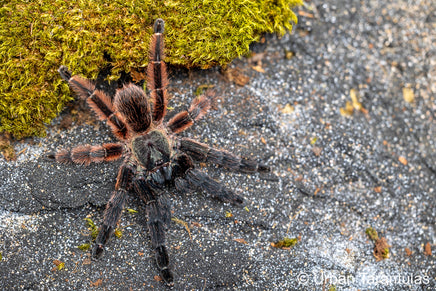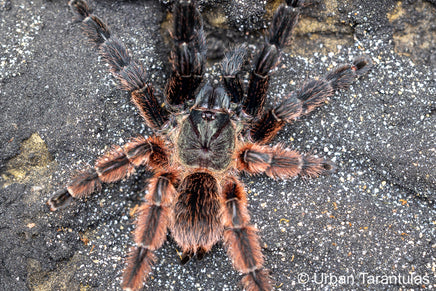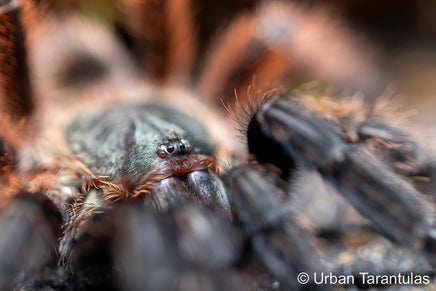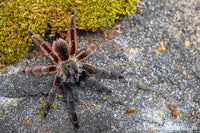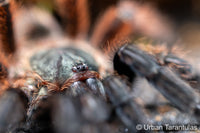For the Psalmopoeus victori, often referred to as the Mexican Half-and-Half Tarantula, let's dive into a unique description that sets it apart from its arachnid counterparts, followed by detailed care instructions, diet preferences, and intriguing species-specific facts.
Introduction
The Psalmopoeus victori, or Mexican Half-and-Half Tarantula, is a striking arboreal species known for its vivid coloration and dynamic lifestyle. With its remarkable speed and agility, the P. victori is a spectacle of natural beauty and behavior. Its contrasting black and orange pattern not only serves as a warning to predators but also captivates the enthusiasts and hobbyists alike. This species' distinctiveness lies not just in its appearance but in its spirited personality, making it a fascinating addition to any collection.
Care Details
Temperature: The ideal range for the P. victori, like most tarantulas, is between 75 to 85°F (24 to 29°C). Tarantulas thrive in warmer environments, exhibiting increased appetite, faster growth, and more frequent molting. This adaptability to various temperatures makes them relatively easy to care for.
Humidity: The Psalmopoeus victori prefers a humidity level of around 70%. While water dishes are not necessary, incorporating one poses no harm. Personally, I opt not to use them, relying on the enclosure's design and maintenance to maintain appropriate humidity levels.
Housing: Being an arboreal species, the housing for P. victori should reflect its natural inclination to climb. For babies, a small vial up to 5 inches tall and 2 inches in diameter with proper ventilation is recommended. Remember, free vials are available at checkout, but you must request one during the process, or it won't be included. For specimens larger than 2 inches, a 7-8 inch tall enclosure is suitable, and adults require 12 to 16 inches to accommodate their climbing and webbing behavior.
Diet
I ensure a varied diet for my tarantulas, including crickets and cockroaches such as Dubia, Red-runner, Lobster, and Madagascar hissing roaches. For the juveniles, smaller prey like baby crickets and roaches are perfect. If a smaller cricket or roach isn't available, simply crush its head and leave it in the enclosure. The P. victori will manage from there. It's crucial to remove uneaten food to avoid mold. Occasionally, a pinky or hopper mouse can be offered as a treat to the adults, but avoid overfeeding rodents and feeder lizards, as excessive calcium can be detrimental.
In-depth Facts
Latin name: Psalmopoeus victori
Common name: Mexican Half-and-Half Tarantula, Darth Maul
Locale: Originating from Mexico, this species showcases the vibrant biodiversity of the region.
Category: Arboreal, with moderate webbing behavior.
Size: Females tend to be larger than males, reaching up to 7.5 inches in leg span. Urticating hairs: The P. victori does not possess urticating hairs, a trait common among many arboreal tarantulas.
Growth rate: Known for a relatively fast growth rate, this species transitions quickly from spiderling to adult.
Life span: Females can live up to 12 years, while males have a shorter lifespan. Recommended for: Lovers of beautiful tarantulas...
Stay Connected
- Instagram: Follow my Instagram, I'm most active here.
- YouTube: For care and education videos, check out my YouTube channel.
- Facebook: Over here I have all my reviews.
- TikTok: Visit my TikTok for additional content.
Safety Disclaimer
Experiencing a tarantula bite is an extremely rare occurrence, and it's important to note that there have been no recorded fatalities due to a tarantula bite. The venom potency varies across species, with Old World tarantulas generally having stronger venom than their New World counterparts. Within the Old World category, the Poecilotheria genus is known for having particularly potent venom.
It's crucial to approach tarantulas with respect and understanding. If you happen to get bitten, which is unlikely, the key is to stay calm. In most cases, the discomfort is superficial and subsides within a few minutes to a few hours. However, bites from species with more potent venom may result in symptoms lasting up to a week. Remember, larger tarantulas tend to have more venom than smaller ones.
Please be aware that I cannot assume responsibility for bites. Tarantula handling should be done at your own risk. In my 11 years of experience with these creatures, I have only been bitten once, by a species with highly potent venom. While the experience was painful, the symptoms had completely disappeared after a week.
Handle tarantulas responsibly, and always prioritize your safety and the well-being of the tarantula.
